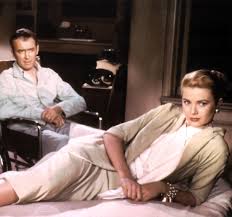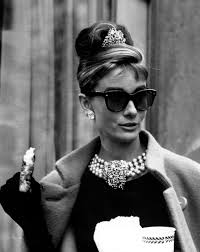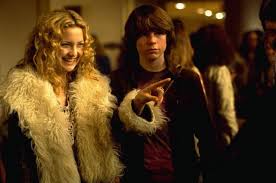If you are in need of major sartorial inspiration,then Holly Golightly (Audrey Hepburn-Breakfast At Tiffany's) or Katherine Hepburn (The Philadelphia Story) can give you that.
Holly’s little black dress, Annie’s baggy khakis, Bonnie’s jaunty beret, Tony’s white polyester suit. The clothes worn by some of moviedom’s most memorable characters have had audiences rushing to replicate the looks for the past 75 years.
THE FORTIES

The Philadelphia Story: She rarely wore skirts off camera, and in the first scenes of this 1940 romantic comedy, style rebel Katharine Hepburn donned a pair of Adrian-designed tailored trousers. Playing Philadelphia socialite Tracy Lord alongside Cary Grant and Jimmy Stewart, the feisty actress helped usher in a new fashion era for women—one in which getting dressed one leg at a time was no longer taboo.
THE FIFTIES

Rear Window: Whether she was leaning in, resplendent in a black-and-white tulle gown, to kiss a slumbering Jimmy Stewart or pulling a satin negligee from a stylish Mark Cross bag, Grace Kelly’s turn as lithesome fashion consultant Lisa Fremont in Alfred Hitchcock’s 1954 thriller was mesmerizing. No binoculars were necessary to spy on this haute, Edith Head-designed wardrobe.
THE SIXTIES


Breakfast at Tiffany’s: Sad-yet-insouciant Holly Golightly may have had the “mean reds,” but it was her little black dress—a Hubert de Givenchy design worn by Oscar-nominated Audrey Hepburn in the opening scene of the 1961 film—that inspired envy and endless imitators. In 2006, one of the three original Italian-satin dresses Givenchy created for costumer Edith Head sold at Christie’s for $467,200.

Belle de Jour: Luis Buñuel’s 1967 film about Séverine, a bored Parisian housewife with a secret sexual life, became a masterpiece partly because of leading lady Catherine Deneuve’s deceptively prim wardrobe of double-breasted coats, collared dresses and simple shifts designed by Yves Saint Laurent and accessorized with Pilgrim pumps by Roger Vivier.

Bonnie and Clyde: As gun moll Bonnie Parker to Warren Beatty’s Depression-era bank robber Clyde Barrow in this Oscar-winning 1967 classic, Faye Dunaway embodied tomboy chic in midi skirts, fitted sweaters and tweed suits designed by Theadora Van Runkle. And nobody wore a wool beret better.
THE SEVENTIES

The Philadelphia Story: She rarely wore skirts off camera, and in the first scenes of this 1940 romantic comedy, style rebel Katharine Hepburn donned a pair of Adrian-designed tailored trousers. Playing Philadelphia socialite Tracy Lord alongside Cary Grant and Jimmy Stewart, the feisty actress helped usher in a new fashion era for women—one in which getting dressed one leg at a time was no longer taboo.
THE FIFTIES
Rear Window: Whether she was leaning in, resplendent in a black-and-white tulle gown, to kiss a slumbering Jimmy Stewart or pulling a satin negligee from a stylish Mark Cross bag, Grace Kelly’s turn as lithesome fashion consultant Lisa Fremont in Alfred Hitchcock’s 1954 thriller was mesmerizing. No binoculars were necessary to spy on this haute, Edith Head-designed wardrobe.
THE SIXTIES
Breakfast at Tiffany’s: Sad-yet-insouciant Holly Golightly may have had the “mean reds,” but it was her little black dress—a Hubert de Givenchy design worn by Oscar-nominated Audrey Hepburn in the opening scene of the 1961 film—that inspired envy and endless imitators. In 2006, one of the three original Italian-satin dresses Givenchy created for costumer Edith Head sold at Christie’s for $467,200.
Belle de Jour: Luis Buñuel’s 1967 film about Séverine, a bored Parisian housewife with a secret sexual life, became a masterpiece partly because of leading lady Catherine Deneuve’s deceptively prim wardrobe of double-breasted coats, collared dresses and simple shifts designed by Yves Saint Laurent and accessorized with Pilgrim pumps by Roger Vivier.
Bonnie and Clyde: As gun moll Bonnie Parker to Warren Beatty’s Depression-era bank robber Clyde Barrow in this Oscar-winning 1967 classic, Faye Dunaway embodied tomboy chic in midi skirts, fitted sweaters and tweed suits designed by Theadora Van Runkle. And nobody wore a wool beret better.
THE SEVENTIES
Love Story: From “Hello, Preppy” to “Love means never having to say you’re sorry”—an Ivy League setting, and beautiful, young, dying Jenny Cavilleri wearing an adorable knit hat—this 1970 tale of opposites attracting and then facing tragedy was guaranteed to start a trend. Starring Oscar nominees Ali MacGraw as the working-class Jenny and Ryan O’Neal as aristocratic Oliver Barrett IV, the movie catapulted wool peacoats, plaid skirts and striped scarves into the fashion stratosphere, setting in motion waves of preppy style to come.
Annie Hall: When Woody Allen’s neurotic comedian Alvy Singer first meets the title character of his Oscar-winning 1977 film, played by Diane Keaton, dressed androgynously in baggy khakis, a men’s dress shirt, a vest, a tie and a fedora, she takes him for a madcap spin in her VW Super Beetle convertible—and the fashion world went along for the ride.
Saturday Night Fever: From his Bee Gees-beat strut to his scene-stealing dance moves, John Travolta as Tony Manero rocked skintight polyester pants, silky Qiana shirts and gold chains in 1977’s other seminal fashion film. This grit-meets-glitter tale not only launched the disco trend, but Travolta’s unbuttoned gyrations gave it worldwide exposure.
THE EIGHTIES
THE EIGHTIES
American Gigolo: Richard Gere was more memorable as the perfect foil for designer Giorgio Armani’s relaxed, luxurious suits than as the title character. This 1980 film about Julian Kay, a Los Angeles escort who liaises with a politician’s wife (played by Lauren Hutton), made the Italian designer a household name. Armani’s silk-and-linen designs looked equally great laid out, piece by piece, on Julian’s bed.
Out of Africa: She had a farm in Africa—and a ruggedly handsome lover played by Robert Redford who washed her hair on a riverbank—but Meryl Streep’s 1985 star turn as Danish writer Karen Blixen is most notable for the great fashion migration it spurred: utilitarian safari jackets and colonial-era shirting dresses. Ralph Lauren built his empire on it, and 30 years later the look remains one of his signatures.
THE NINETIES
Pulp Fiction: As Mia Wallace in Quentin Tarantino’s stylized 1994 hit man saga, Cleopatra-coiffed Uma Thurman sported a fitted white shirt and cropped black pants, a look that became one of the decade’s most coveted and copied. Costars John Travolta and Samuel L. Jackson’s black suits and skinny ties embodied Tarantino’s modern gangster—blood spatter optional.
THE 2000s

Almost Famous: In this 2000 Cameron Crowe film, Betsy Heimann, who also designed the Pulp Fiction costumes, tapped into California girl (and Oscar nominee) Kate Hudson’s bohemian style to outfit her Seventies rock groupie character, Penny Lane. In the process, the duo unknowingly created the template for all future Coachella-goers .
The 2010s
Almost Famous: In this 2000 Cameron Crowe film, Betsy Heimann, who also designed the Pulp Fiction costumes, tapped into California girl (and Oscar nominee) Kate Hudson’s bohemian style to outfit her Seventies rock groupie character, Penny Lane. In the process, the duo unknowingly created the template for all future Coachella-goers .
The 2010s
American Hustle: With Hollywood Fashion Tape in a supporting role, Oscar nominee Amy Adams outfoxed costume designer Michael Wilkinson’s plunging, disco-era Halston- and Gucci-inspired ensembles in this 2013 film about con men, political bribes and bad perms. Add Jennifer Lawrence’s overdone suburbanite style, and then cue Seventies looks on fashion runways for spring and pre-fall 2015.

No comments:
Post a Comment